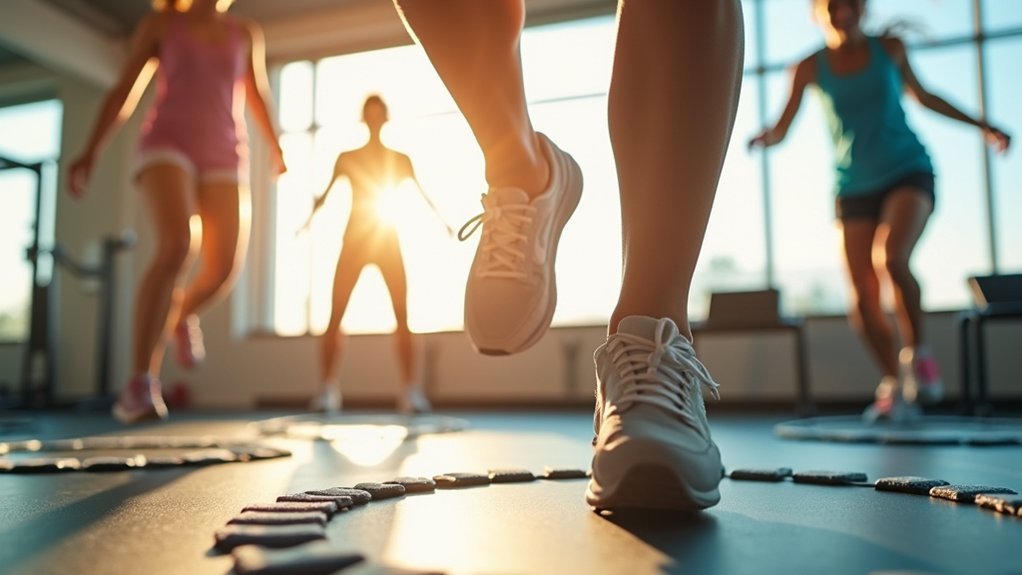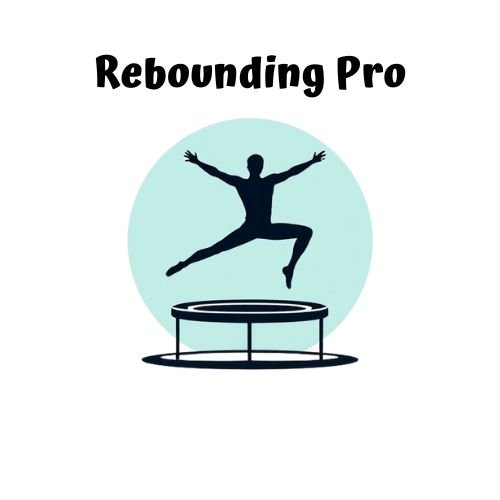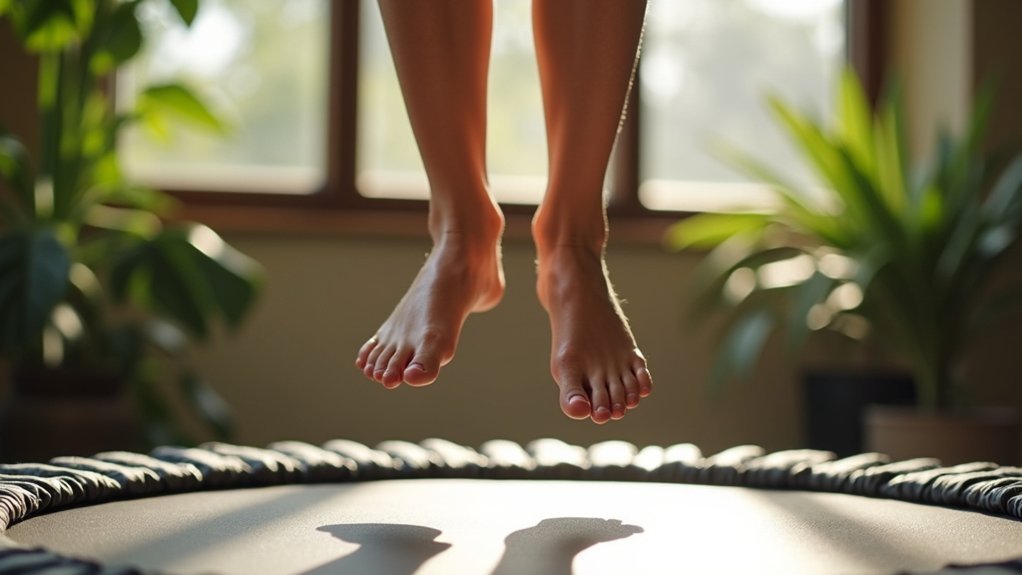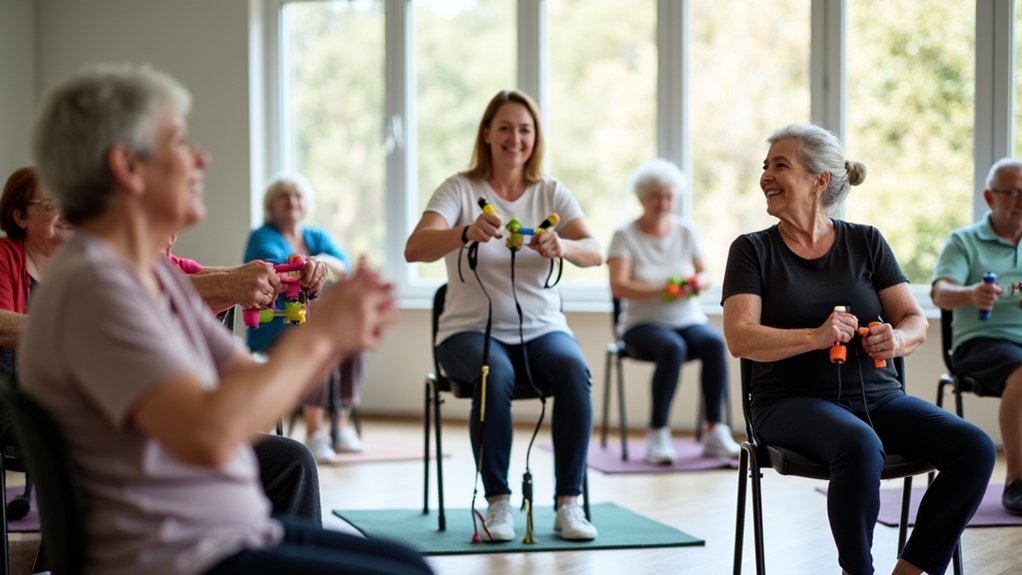Rebound workouts are easy on your joints because the trampoline surface absorbs up to 87% of impact forces. You’ll experience 80% less joint stress compared to high-impact exercises like running. The elastic surface distributes pressure evenly across your body rather than concentrating it on specific joints. Your stabilizer muscles activate during bouncing, improving joint alignment and protection. NASA research confirms these benefits, showing rebounding provides greater bio-mechanical stimulus with considerably less joint strain. Discover how this gentle yet effective exercise can transform your fitness routine.
Why Are Rebound Workouts Easy On Joints?

While high-impact exercises can wreak havoc on your body, rebound workouts offer a gentler alternative that still delivers impressive results. The trampoline’s surface absorbs shock during movement, greatly reducing stress on your knees, hips, and spine.
Unlike running or jumping on hard surfaces, rebounding distributes impact evenly throughout your body. You’ll experience up to 80% less joint stress while still enjoying an effective workout. The trampoline activates smaller stabilizing muscles that support proper joint alignment, promoting long-term joint health.
What makes rebounding truly remarkable is how it accommodates high-intensity exercise without the joint punishment. This makes it ideal for those with existing joint issues or anyone looking to prevent future problems. The gentle bouncing motion stimulates synovial fluid circulation, which is essential for joint lubrication and nourishment.
Even during recovery, rebounding can support healing while maintaining fitness levels.
The Science Behind Shock Absorption in Rebounding
Rebounding workouts distribute impact forces evenly throughout your body, with the trampoline’s springs absorbing up to 87% of the shock that would normally strain your joints.
Unlike running on hard surfaces where your ankles and knees bear most of the impact, NASA research confirms that trampoline exercise reduces joint stress while still providing effective G-force stimulation.
This even distribution of gravitational forces allows you to strengthen your musculoskeletal system without the wear and tear associated with high-impact activities. This makes rebounding particularly beneficial for people with joint issues or arthritis who still want to maintain an active lifestyle.
Impact Force Distribution Mechanics
When you jump on a rebounder, complex physics comes into play that protects your joints from harmful impact. Unlike hard surfaces, rebounders distribute pressure across wider areas, preventing concentrated force on any single joint point.
As your feet make contact, the trampoline surface creates varying pressure zones that radiate outward from the impact point. This non-uniform distribution prevents damaging focal stress concentrations on your ankles, knees, and hips.
The compliant surface increases contact area during impact, transforming much of your kinetic energy into elastic potential energy rather than jarring force. Internal boundary layers within the rebounding material create velocity gradients that redirect stress away from your joints. Studies using direct numerical simulations demonstrate how this energy transformation significantly reduces joint strain compared to hard surface impacts.
This sophisticated force distribution extends impact duration, allowing your body to manage the forces gradually rather than absorbing sudden shocks.
Spring-Loading Versus Hard Surfaces
The fundamental difference between a rebounder and hard surfaces lies in their shock absorption capabilities.
When you exercise on concrete or pavement, your body absorbs up to 100% of the impact force, placing significant stress on your joints, potentially leading to conditions like shin splints and plantar fasciitis.
By contrast, rebounders utilize spring-loading mechanisms that mimic your body’s natural elastic energy storage systems. These springs absorb and redistribute impact forces, reducing joint stress by up to 87%.
Your body can maintain nearly isometric muscle contractions during movement on springy surfaces, decreasing metabolic energy expenditure while improving efficiency. Research suggests that springier surfaces may significantly reduce joint stress compared to harder surfaces like concrete or asphalt.
While some studies show minimal differences in plantar pressure between surfaces, the cumulative effect of reduced impact forces during repetitive movements makes rebounding a joint-friendly alternative to high-impact workouts on hard surfaces.
NASA’s Gravitational Research Findings
NASA’s groundbreaking research has validated what rebounding enthusiasts have long suspected about this exercise’s joint benefits.
Unlike running, where G-forces at the ankle are twice as high as at the back and forehead, rebounding distributes impact forces uniformly throughout your body, keeping them well below dangerous thresholds.
When you bounce on a trampoline, you’re experiencing:
- Nearly identical G-forces across ankle, back, and forehead regions, protecting vulnerable joints
- A bio-mechanical stimulus greater than running at the same heart rate and oxygen consumption
- Low-impact gravitational loading that strengthens bones and muscles without joint strain
- Efficient energy use with up to 68% greater work output compared to running at similar oxygen intake levels
This “gravireceptor stimulation” method allows you to achieve significant fitness benefits while preserving joint health.
The research revealed that just 10 minutes of rebounding provides cardiovascular benefits equivalent to 30 minutes of running, making it both joint-friendly and time-efficient.
How Spring-Loaded Surfaces Distribute Impact Forces
When you jump on a rebounder, the technical springs beneath your feet employ precise engineering mechanics to transform harmful impact forces.
The spring rate and material properties work together to extend your deceleration time, reducing peak forces by distributing them over milliseconds rather than instantaneously.
This force redistribution pattern mimics your body’s natural shock absorption systems, allowing your joints to experience gentler loading compared to hard-surface exercises. You may experience occasional validation delays while accessing instructional rebounding content during peak usage times.
Spring Engineering Mechanics
Understanding how spring-loaded surfaces work reveals why they’re so effective at protecting your joints during rebound exercises.
When you jump on a spring-loaded surface, the springs convert your kinetic energy into elastic strain energy, spreading the impact force over time and distance rather than creating an instant shock to your joints.
Spring design involves a critical balance between stiffness and flexibility. Softer springs create greater deflection distances, reducing peak forces on your joints, while still providing enough resistance for effective rebounding. Technical springs are essential for effective force distribution across structures, preventing stress concentrations in any single area.
- Compression springs absorb vertical forces by shortening under your weight
- Maximum force decreases as spring deflection distance increases
- Springs convert sudden impacts into gradual, controlled movements
- Different spring types (compression, tension, torsion) address various movement patterns and force directions
Force Redistribution Patterns
Unlike rigid surfaces that concentrate impact into painful joint-jarring shocks, spring-loaded surfaces intelligently redistribute forces throughout your entire workout.
When you jump on a rebounder, the springs create a dynamic force-sharing system that spreads impact across a larger area rather than focusing it on your ankles, knees, or hips.
This redistribution works through a process called dynamic support, where the surface adjusts to your specific movements and weight.
As you land, the springs compress to absorb the force, then release it gradually rather than instantly returning it to your body. The fundamental principle at work follows the formula F = k * x, where spring rate determines how much force is returned to your body over distance traveled.
You’ll notice even distribution of pressure across your feet instead of concentrated points of stress.
This pattern of force redistribution considerably reduces stress concentrations on your joints, making rebound workouts remarkably gentler than exercises on traditional surfaces.
NASA’s Findings on Gravitational Stress Reduction

Throughout decades of space research, NASA has discovered that microgravity environments greatly reduce stress on human joints, offering valuable insights for Earth-based exercise methods. Their findings directly inform why rebounding works so well for joint health.
When you jump on a rebounder, you’re experiencing a form of gravitational manipulation similar to what NASA studies in space. The mini-trampoline creates moments of weightlessness followed by controlled resistance that:
- Redistributes bodily fluids more evenly, reducing pressure on lower extremity joints
- Simulates aspects of microgravity that allow for movement without the harsh impact of Earth’s gravity
- Provides cardiovascular benefits without the joint stress of traditional weight-bearing exercises
- Creates a form of variable resistance that strengthens muscles around joints without compression damage
Texas A&M University’s research into the effects of altered gravity vectors on cardiovascular systems provides valuable insights into how rebounding creates healthier exercise conditions for our bodies.
Stabilizer Muscle Engagement and Joint Protection
Building on NASA’s findings, the body’s protective mechanisms further explain why rebounding offers exceptional joint support. When you bounce, your stabilizer muscles activate before your prime movers, preparing joints for movement through feed-forward neural control and anticipatory co-contraction.
This simultaneous contraction of antagonist and agonist muscles increases joint stiffness, providing resistance against unwanted movements and distributing loads evenly across joint surfaces. The variable resistance naturally created during rebounding encourages graded stabilizer engagement throughout motion ranges. Rebounding effectively engages the transverse abdominis, which wraps around your abdomen to provide critical spine and pelvis stabilization during the bouncing motion.
Additionally, rebounding enhances proprioceptive feedback, improving your awareness of joint position and enabling more precise control. Your deep stabilizers maintain proper alignment during bouncing, while the elastic nature of the rebounder surface stimulates these protective muscles without overwhelming them, creating an ideal environment for safe, joint-friendly exercise.
Core Strength Development for Better Joint Support

When you rebound regularly, your core musculature transforms into a protective fortress for your joints. These essential muscles—including your abs, back, and pelvic floor—distribute weight more evenly across your body, considerably reducing joint pressure during movement.
Consistent rebounding naturally engages these stabilizing muscles, helping you develop core strength through proper technique and progressive difficulty. This type of exercise provides crucial stability and balance while connecting your upper and lower body functions.
Regular rebounding activates your stabilizers, building core power naturally as you master techniques and increase challenge.
As your core becomes stronger, you’ll notice:
- Reduced stress on knee, ankle, and hip joints during everyday activities
- Enhanced posture and spinal alignment, preventing back pain
- Improved balance and coordination, minimizing fall risks
- Better athletic performance through increased stability and power transfer
Rebounding’s Role in Improving Balance and Proprioception
As you bounce on a rebounder, your body receives a powerful education in balance and spatial awareness. Each landing stimulates proprioceptors in your joints, enhancing your sense of body position while refining neuromuscular control.
The unstable, dynamic surface challenges your vestibular system with every bounce, improving your equilibrium and spatial orientation. Your stabilizer muscles—from feet to core—constantly engage to maintain balance, strengthening these joint-supporting structures.
You’re fundamentally practicing controlled falling with each bounce, training reflexive stabilization responses that protect joints during daily activities. This repetitive motion enhances your body’s balance recovery mechanisms while minimizing stress on joint structures. This low-impact exercise provides effective fitness benefits without putting excessive pressure on your joints compared to traditional high-impact workouts.
The cognitive-motor integration benefits further support joint health by improving your brain’s processing of movement and position information.
Osteoblast Stimulation and Bone Density Benefits
NASA studies have shown that rebounding creates variable G-forces that stimulate your osteoblasts to build stronger, denser bones while reducing osteoclast activity.
These mini-trampolines provide the mechanical loading needed to trigger bone formation without the harsh impact of traditional exercises, making them ideal for those with joint pain or osteoporosis risk. The gentle bouncing motion encourages bone tissue remodeling, which is essential for maintaining healthy and resilient skeletal structures.
You’ll feel less joint pain over time as your bone matrix strengthens and your skeletal system adapts to this gentle yet effective form of resistance training.
NASA-Backed Bone Research
Extensive research conducted through NASA’s space medicine programs has revealed remarkable insights into how mechanical stimulation affects bone health.
Studies show that low magnitude, high frequency (LMHF) movements—precisely the type you experience during rebounding—trigger increased osteoblast activity, promoting bone formation even with minimal strain.
- Brief daily rebounding sessions (around 15 minutes) can greatly improve bone formation rates
- LMHF mechanical signals as low as 70 microstrain at 30 Hz effectively inhibit bone resorption
- Rebounding-type movements help normalize bone formation impaired by disuse or microgravity
- These gentle, repetitive forces increase osteoblast proliferation without altering bone length or matrix composition
NASA’s mathematical models confirm that these forces balance the activity of bone-building osteoblasts against bone-resorbing osteoclasts, making rebounding an effective countermeasure against bone density loss.
Stronger Bones, Less Pain
While many exercise options promise bone health benefits, rebounding stands out for its remarkable ability to stimulate osteoblasts—the cells responsible for building bone tissue. Each bounce creates varied gravitational forces that gently squeeze your cells, triggering bone-building activity that combats age-related bone loss. Studies consistently demonstrate that trampoline exercisers experience higher bone density compared to those using conventional treatments.
| Bone Benefit | How Rebounding Helps |
|---|---|
| Increased Density | Significant improvements in fracture-prone areas like hips |
| Reduced Fracture Risk | Low-impact loading strengthens bones more safely than high-impact exercise |
| Better Posture | Enhanced bone mass provides improved skeletal support |
You’ll experience these benefits without the joint strain of other exercises since the trampoline absorbs 87% of impact shock. This means you can exercise longer while strengthening bones and avoiding the joint pain that typically accompanies weight-bearing workouts.
Clinical Evidence for Joint Pain Reduction
Research consistently demonstrates that rebounding exercises provide substantial relief for those suffering from joint pain and related conditions. Clinical trials show that mini-trampoline workouts outperform walking and cycling for managing osteoarthritis and rheumatoid arthritis symptoms. The elastic surface absorbs impact forces that would otherwise stress damaged joints. The low impact nature of rebounding exercises makes them particularly beneficial for protecting the spine while strengthening back muscles.
- Studies using the Short Form Brief Pain Inventory confirm significant reductions in pain severity after consistent rebounding programs.
- Rehabilitation research verifies improvements in strength, endurance, and quality of life for musculoskeletal patients.
- Enhanced lymphatic flow helps remove inflammatory substances from joints, reducing swelling.
- NASA research supports rebounding’s unique mechanical benefits for musculoskeletal health maintenance.
These benefits make rebounding an evidence-based option if you’re managing joint pain or recovering from injury.
Comparing Impact Forces: Rebounding vs. Traditional Cardio
When you compare rebounding to traditional cardio exercises like running, the impact forces on your joints are greatly reduced, with NASA research showing rebounding distributes force more evenly throughout your body.
This lower impact translates directly to decreased injury risk, particularly for your knees and ankles which absorb most of the shock during high-impact activities. Rebounding’s gentle bouncing motion provides effective exercise without the harsh impact of activities like running or jump rope.
You’ll experience the cardiovascular benefits of exercise while subjecting your joints to only a fraction of the stress, making rebounding a sustainable option for long-term fitness.
Impact Forces Measured
Although many exercise enthusiasts focus primarily on calorie burn, the impact on joints represents an essential factor when choosing between workout options.
NASA’s research demonstrates that rebounding delivers comparable cardiovascular benefits to running while considerably reducing joint stress.
When you rebound, the trampoline absorbs and distributes impact forces throughout your body, unlike running where your joints directly absorb each stride on hard surfaces. This difference isn’t just noticeable—it’s measurable.
- Running can place up to 3x your body weight in force on your knees and ankles.
- Rebounding reduces impact forces by up to 87% compared to running.
- A properly designed rebounder absorbs approximately 80% of landing impact.
- You’ll experience cardiovascular benefits without the joint wear associated with high-impact exercises.
Rebounding is especially popular because it provides an excellent cardiovascular workout while being gentle on your joints, making it accessible for people of all fitness levels.
Injury Risk Assessment
Despite their similar cardiovascular benefits, rebounding and traditional cardio activities differ dramatically in injury risk profiles.
When you opt for rebounding, you’re choosing a low-impact exercise that places considerably less stress on your joints compared to running or jogging. The springy surface absorbs shock associated with exercise movements, creating a gentler environment for your joints.
Traditional cardio often leads to overuse injuries through repetitive high-impact movements, potentially causing long-term joint damage. In contrast, rebounders distribute force more evenly, reducing injury potential while still delivering effective workouts.
The statistics are telling—while trampoline activities do account for injuries, they’re far fewer than those from high-impact sports when proper safety measures are followed.
Using safety handles and maintaining quality equipment further minimizes risks. This makes rebounding particularly valuable in rehabilitation settings, where it strengthens muscles without compromising joint health.
Lymphatic Drainage and Joint Inflammation Management
The lymphatic system plays an essential role in managing joint inflammation by effectively removing excess fluid, toxins, and inflammatory substances from tissues.
Rebounding activates this system through the alternating compression and decompression that occurs with each bounce, creating a pumping effect that stimulates lymphatic flow.
When your lymphatic system functions efficiently, you’ll experience:
- Reduced joint swelling and inflammation as inflammatory mediators are cleared more efficiently
- Decreased pain perception due to the release of endorphins during gentle bouncing movements
- Improved joint mobility resulting from reduced stiffness and pressure on sensitive tissues
- Enhanced immune regulation as immune cells circulate more effectively throughout your body
This natural drainage mechanism makes rebounding particularly beneficial for those with arthritis or recovering from joint injuries. Similar to professional lymphatic drainage massage, rebounding uses light pressure techniques to encourage lymph to move more freely throughout the body.
Customizing Rebounding Intensity for Joint Health
Complementing the benefits of lymphatic drainage, finding the right rebounding intensity for your specific joint needs can make all the difference between a therapeutic workout and an uncomfortable experience.
The beauty of rebounding lies in its adaptability—you can start with gentle health bounces where your feet barely leave the mat, then gradually progress as your joints adapt.
Begin with short 2-5 minute sessions of low-impact movement, allowing the trampoline’s surface to absorb shock while distributing landing forces evenly. The Health Bounce is particularly effective as it keeps your feet close to the mat while still providing significant physiological benefits.
As you build confidence, incorporate slow jogging or interval training to increase cardiovascular benefits without additional joint stress.
For maximum joint protection, consider a bungee-based rebounder that reduces ground reaction force to approximately 1/6 that of walking on pavement, while actively engaging the stabilizing muscles that support your joints.
Rehabilitation Applications for Injured Joints
When recovering from joint injuries, rebounding offers a unique therapeutic advantage that traditional rehabilitation methods often can’t match. The gentle bouncing motion provides proprioceptive stimulation while minimizing compressive forces on damaged tissues, allowing you to begin weight-bearing exercises earlier in your recovery journey. Early rehabilitation participation enables maintenance of cardiovascular fitness without compromising joint healing. Following a proper treatment protocol will maximize the benefits of rebound workouts during your recovery phase.
- Gentle vertical motion reduces stress on healing structures like tendons, ligaments, and cartilage compared to higher-impact activities.
- Low-impact nature makes rebounding suitable for tendinopathies, meniscus injuries, and ligament sprains while preventing flare-ups.
- Rhythmic bouncing enhances neuromuscular control and joint stability, critical components for preventing re-injury during rehabilitation.
Your physical therapist can incorporate rebounding into your recovery plan, gradually increasing intensity as your joint function improves.
Long-Term Joint Preservation Through Low-Impact Exercise
Regular engagement in low-impact exercises provides critical long-term benefits for your joints, extending their functional lifespan well beyond what sedentary lifestyles allow.
By incorporating activities like swimming, walking, and cycling into your routine, you’ll strengthen the muscles surrounding your joints while minimizing harmful impact.
The key to joint preservation lies in consistency and progression. Start slowly, gradually increase intensity, and always listen to your body’s signals. Using heat before your workout helps relax joints and muscles for more comfortable movement.
Combine aerobic activities with flexibility exercises and targeted strength training using resistance bands or light weights to create a thorough approach.
Maintaining a healthy weight through these exercises further reduces strain on your joints.
Frequently Asked Questions
How Long Until Joint Pain Improves After Starting Rebounding?
You’ll likely notice initial joint pain improvements in 2-4 weeks with consistent rebounding. Significant relief typically develops after 8-12 weeks of regular practice, though your results may vary based on your individual joint health.
Can Rebounding Help With Specific Conditions Like Plantar Fasciitis?
Rebounding may help your plantar fasciitis by strengthening foot muscles and providing low-impact exercise. While research is limited, the gentle bouncing motion can improve circulation and reduce inflammation in your feet.
Are All Rebounders Equally Effective for Joint Protection?
No, all rebounders aren’t equally effective for joint protection. You’ll get better results from models with bungee cord suspension, high-quality materials, adequate weight capacity, and adjustable tension that matches your specific needs.
How Does Rebounding Compare to Water Aerobics for Arthritis?
Both rebounding and water aerobics protect your joints while managing arthritis. Water offers more buoyancy and joint offloading, but you’ll get better lymphatic benefits from rebounding. Either choice improves mobility and reduces pain.
Should Seniors Modify Rebounding Techniques for Joint Safety?
Yes, you should modify rebounding techniques for joint safety. Use stability bars, maintain gentle bounces, keep slight knee bends, start with short sessions, and wear non-slip footwear to protect your joints while enjoying the benefits.
In Summary
You’ve discovered why rebounding is the perfect solution for your joints. The elastic surface absorbs up to 80% of impact forces, distributing them evenly throughout your body. Your stabilizer muscles strengthen while the gentle movement stimulates lymphatic flow, reducing inflammation. Whether you’re recovering from injury or protecting your joints long-term, you’ll enjoy effective exercise without the wear-and-tear of traditional workouts. Your joints will thank you!





Leave a Reply